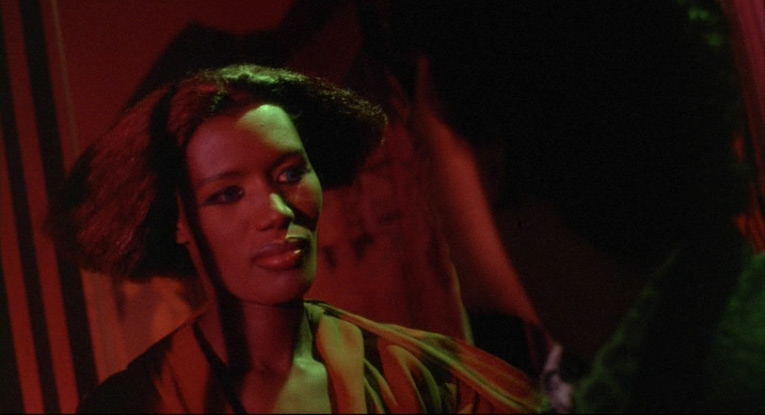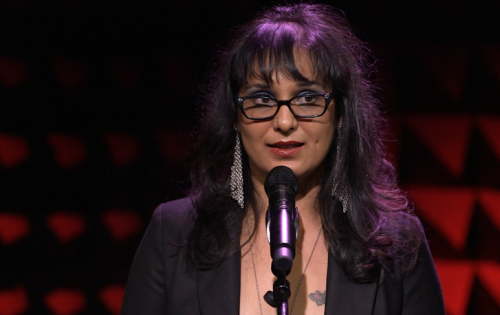This guest post written by Ashlee Blackwell originally appeared at Graveyard Shift Sisters and appears here as part of our theme week on Ladies of the 1980s. It is cross-posted with permission.
Horror in the 1980s saw its most economically prosperous boom ever with droves of young audiences flocking to the theaters each weekend to catch the latest mainstream fare and the independent distribution circuit got a taste for massive dollar returns thanks to VHS technology, video rental stores, and small film companies not yet chewed and swallowed by the landmark Telecommunications Act in 1996. The abundance of films were endless. So much so, myself and other horror aficionados are still combing purposely through the virtual racks to find untapped treasures, and others we loved but don’t remember by name. Unsurprising, diverse character representations weren’t necessarily a part of this equation.
The best description of Black characters in horror films in the 1980s is “fairly fleeting or nonexistent.” With major horror films in settings that reflected the “white flight” from “urban” (read: poor/working class, people of color) spaces, the reality of camps, suburbs, and modern, renewal terrains is where supernatural forces found a home away from the reality-based, city horrors. Of course, you had both non-White interlopers as insignificant, stand-in characters (actor Richard Lawson as Ryan in Poltergeist comes to mind) and the fly in the buttermilk characters I often mirror with the trend of the Black middle class during this time.
With sparse African American presence on this foundation, “Black characters’ value was confined to their ability to affect an assimilable air in cross-racial, interpersonal encounters,” often reduced to tokenized roles that saw them “blend” in with the group with no discernible interest in fleshing their characters out, making them just as multi-faceted, whole individuals as their white counterparts. However, I do thoroughly enjoy and sometimes defend 80s horror and the Black (female) characters I can find, but it’s crucial to examine the narrow confines of their characterization. While it was important for them to be “seen,” it’s disheartening that they were left to our imaginations to assess their merit.
Below are three of note, as they are as diverse in characterization as they are in setting. Within the realm of Black women in 1980’s horror films, they are standouts and widely recognized; funny enough because they are amongst the few.
Grace Jones as Katrina in Vamp (1986)
There’s one self-indulgent wish I have: to go back a few years to the pop culture conference I attended and to not have another meeting conflict with one graduate student’s presentation on Grace Jones’ vampiric performance in this film. I’m still wildly interested in the author’s thoughts on the dynamics of this character. There’s a lot to say about a significant character who does not speak. Your understanding comes from Katrina’s movements and reactions to those with whom she interacts. Katrina is feared, respected, and desired as any head vampress of a seedy strip club should be. Regardless of the film’s camp, it’s sort of an original step with Jones’ personae bringing to life such art and terror to a memorable character.
Toy Newkirk as Sheila Kopecky in A Nightmare on Elm Street 4: The Dream Master (1988)
It’s not without surprise to those in-the-know that this character is a personal favorite. Sheila is the first casualty of the barrier broken between the “Elm Street children” and the “fresh meat.” She is the Black friend who her white high school co-horts depend on for math tutoring and bug zappers. She is a part of the white female protagonist’s (Alice) arc in avenging her fallen friends and defeating Freddy. And in step with this particular Elm Street franchise installment and the famed sentiment, she proves the rule loosely solidified in this decade that the Black person does die first.
We don’t learn much about Sheila: we don’t see her at home, with family, taking interest in anyone romantically, or alone with her thoughts. To be fair, that’s not the tone of this film with a clear focus on Alice vs. Freddy. A small grace that Sheila offers is the fact that she strays heavily from caricature often associated with Black women in mainstream films. She wasn’t a “sassy, eccentric, magical servant,” a trope long associated with Black women in horror films long before the blaxploitation period in the 1970s. In fact, she was an extroverted nerd. Because this is a character so rare, if arguably non-existent for Black women on screen, it makes A Nightmare On Elm Street 4 revolutionary.
Lisa Bonet as Epiphany Proudfoot in Angel Heart (1987)
An ethereal presence in a surreal mystery, Epiphany provided both distraction and information to Harry Angel (Mickey Rourke), a private investigator who travels down to the American south to find the whereabouts of a musician named Johnny Favorite. The story was Angel’s; Epiphany’s presence had its share of significance considering the structure of the story. Bonet’s role was of a mystical practitioner of voodoo, more inclined to offer Angel rather cryptic facts about her mother, Evangeline who was the deceased lover of Favorite’s. Angel Heart‘s place in genre as a period mystery has me refraining from revealing too much of the story, but the beats that addressed matters of race are much better for analysis than the prior two films mentioned.
It is difficult to separate artist from the art here. Bonet was on a highway to super stardom during the film’s release, and her explicit love scene with Rourke’s character, considering their age difference and grisly imagery accompanying, sent a tizzy of rumors spiraling, citing this role as possibly being one of the reasons she and Bill Cosby were infamously at odds which Bonet has disputed.
In what may be considered more cult than mainstream, Angel Heart has earned its stripes as being one of the more bold and richly dark thrillers of the decade.
With a significant absence of Black filmmakers creating work in horror during the 1980s, representation was scant. Black characters were villains, supportives, and ultimately, victims just like other disposable characters. The problem lies in a lack of consideration for non-White actors to receive fulfilling, leading roles, not matter how slashery a horror film in the 80s was. It took the renaissances of Black cinematic genre storytelling of the 1970s and 1990s to bring more compelling roles back to these characters, Black women in particular. They have set the tone for what mainstream and independent horror filmmakers of any background are slowly but steadily doing today.
However, the 80s opened up a dialogue about where Black women’s place was not only in society, but in horror. Katrina demonstrates a stark fear of “the Other” who dwells beyond the parameters of the safe, White institutions, Sheila is a marker of assimilation and the rise of the Black middle class with a Huxtable like allure, while also being a Black girl nerd we like, and Epiphany is rooted in a past that Reagan’s message to America desired; a return to the good ‘ole days when miscegenation was taboo if not illegal. This may not have been a time to necessarily celebrate representation and diversity in the genre. But there’s enough open for much discourse that, whether intended or not, these films have left for its consumers to chew on for years to come.
References:
*Additional information and references not linked are from Dr. Robin Means Coleman’s book, Horror Noire: Blacks in American Horror Films from the 1890s to Present. New York: Routledge, 2011.
Ashlee Blackwell is the founder and managing editor of Graveyard Shift Sisters, a website dedicated to highlighting the work of women of color in the horror and science fiction genres. She holds a MA in Liberal Arts from Temple University and aspires to bring intersectional horror into the college classroom.











